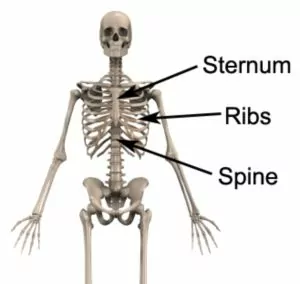Rib Fracture
Updated:
(Also known as a Broken Rib, Fractured Rib)
What is a rib fracture?
A rib fracture (or broken rib) is a relatively common condition characterized by a break in one of the rib bones that form the chest and upper back (figure 1).

The chest comprises of 12 rib bones on each side of the body. Each rib attaches to the spine at the back of the body and then travels around to the front of the chest (figure 1). The top 7 ribs attach to the sternum, the 8th to 10 ribs attach to the ribs above via cartilage and the 11th and 12th ribs are known as ‘floating’ ribs as they are unattached at the front of the chest.
Following a direct blow to the front or side of the chest, or, upper back, stress is placed on the ribs, which may cause injury. This can result in a bruised rib or if the impact is traumatic and beyond what the bone can withstand, a break in the rib may occur. This condition is known as a rib fracture.
Occasionally a rib fracture may result in damage to other organs of the body such as the lungs (e.g. a pneumothorax), liver, spleen or kidney. This more commonly occurs if the fracture is severe and displaced.
Cause of a rib fracture
A rib fracture usually occurs following a traumatic, direct blow to the ribs from an object or person. This most commonly occurs due to a collision with another player during contact sports, such as football or rugby, or from an impact from a ball in sports such as hockey or cricket. Rib fractures may also occur during other traumatic events such as a motor vehicle accident or fall from a height.
Signs and symptoms of a rib fracture
Patients with a broken rib typically experience a sudden onset of chest pain, mid back pain or pain in the side of the ribs at the time of injury that occasionally may radiate into the back, shoulder or neck. Pain is often sharp and intense and may increase during deep breathing, coughing, laughing or sneezing.
Patients may also experience an ache in the ribs that is particularly prominent at night or first thing in the morning (particularly the first few days following injury). Pain may increase when lying on the affected side, applying pressure to the rib region or on firmly touching the rib at the site of injury. Patients may also experience pain during movements of the upper back such as bending or twisting, or sometimes during certain activities of the upper limb (such as overhead activities, or during heavy pushing, pulling or lifting).
Diagnosis of a rib fracture
A thorough subjective and objective examination from a physiotherapist is important to assist with diagnosis of a fractured rib and to determine the likelihood of associated damage to other organs such as the lungs (e.g. a pneumothorax), liver, spleen or kidneys. Investigations such as an X-ray, MRI or CT scan may be performed to confirm diagnosis.
Treatment for a rib fracture

Members Only ContentBecome a PhysioAdvisor Member to gain full access to this exclusive content. For more details see Become a Member. Already a member? Login Now
Prognosis of a rib fracture
Patients with a fractured rib usually make a full recovery with appropriate management. Patients can usually return to activity or sport in a number of weeks (or in some cases, months) although care must be taken when returning to contact sports as the rib is unlikely to regain full strength for many months.
Physiotherapy for a rib fracture
Physiotherapy treatment can assist patients with this condition and ensure they have a safe return to activity. Treatment may comprise:
- education
- rest from aggravating activities
- dry needling
- protective padding
- exercises to improve posture, flexibility and strength, and to prevent localized lung collapse
- activity modification advice
- taping techniques (e.g. postural taping)
- a graduated return to activity plan
- soft tissue massage
- joint mobilization (usually following completion of fracture healing)
- electrotherapy
Other intervention for a rib fracture
Despite appropriate management, some patients with a broken rib do not improve and require other intervention to ensure an optimal outcome. The treating physiotherapist or doctor can advise on the best course of management when this is the case. This may include further investigations such as X-rays, CT scan or MRI, extended periods of rest, or referral to appropriate medical authorities who can advise on any intervention that may be appropriate to improve the condition.
Exercises for a rib fracture
The following exercises are commonly prescribed to patients with this condition. You should discuss the suitability of these exercises with your physiotherapist prior to beginning them. Generally, they should be performed 3 times daily once the physiotherapist has indicated it is safe to do so and only provided they do not cause or increase symptoms.
Your physiotherapist can advise when it is appropriate to begin the initial exercises and eventually progress to the intermediate and advanced exercises. As a general rule, addition of exercises or progression to more advanced exercises should take place provided there is no increase in symptoms.
Initial Exercises
Shoulder Blade Squeezes
Begin sitting or standing tall with your back straight (figure 2). Squeeze your shoulder blades together as far as you can go without pain and provided you feel no more than a mild to moderate stretch. Hold for 1-2 seconds and repeat 10 times provided there is no increase in symptoms.

Deep Breathing
Begin sitting or standing tall with your back straight (figure 3). Breathe in as deeply as possible without increasing symptoms and then relax. Focus on breathing with your lower lungs (instead of elevating your shoulders), gently expanding your lower ribs. Repeat 5 times.

Rotation in Sitting
Begin sitting tall, with your arms across your chest. Keeping your legs still, gently rotate to one side as far as you can go without pain and provided you feel no more than a mild to moderate stretch (figure 4). Hold for 1 – 2 seconds and repeat 10 times to each side, alternating sides, provided the exercise is pain free.

Intermediate Exercises

Members Only ContentBecome a PhysioAdvisor Member to gain full access to this exclusive content. For more details see Become a Member. Already a member? Login Now
Advanced Exercises

Members Only ContentBecome a PhysioAdvisor Member to gain full access to this exclusive content. For more details see Become a Member. Already a member? Login Now
Rehabilitation Protocol for a rib fracture

Members Only ContentBecome a PhysioAdvisor Member to gain full access to this exclusive content. For more details see Become a Member. Already a member? Login Now
 Physiotherapy products for a rib fracture
Physiotherapy products for a rib fracture
Some of the most commonly recommended products by physiotherapists to hasten healing and speed recovery in patients with this condition include:
To purchase physiotherapy products for a fractured rib, click on one of the above links or visit the PhysioAdvisor Shop.
 Find a Physio for a rib fracture
Find a Physio for a rib fracture
Find a physiotherapist in your local area who can treat this condition.
 More Exercises
More Exercises
- View more Upper Back Stretches.
- View more Upper Back Strengthening Exercises.
- View more Core Exercises.
- View more Scapular Stability Exercises.
- View more Pilates Exercises.
 More Information
More Information
- Read about Posture.
- Read about Postural Taping.
- View detailed information on when to use Ice or Heat.
- View detailed information on initial injury management and the R.I.C.E. Regime.
- View detailed information on Warming Up and Cooling Down.
- View detailed information on Returning to Sport.
- View detailed information on Returning to Running.
- View our Upper Back & Chest Diagnosis Guide.
Become a PhysioAdvisor Member

Link to this Page
If you would like to link to this article on your website, simply copy the code below and add it to your page:
<a href="https://physioadvisor.com.au/injuries/upper-back-chest/rib-fracture”>Rib Fracture – PhysioAdvisor.com</a><br/>A rib fracture (or broken rib) is a relatively common condition characterised by a break in one of the rib bones that form the chest and upper back.
Return to the top of Rib Fracture.








